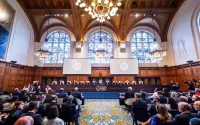25 May 2007The Independent
The Eco-House, the one which doesn't damage the planet with its profligate energy use, has just got closer.
Not as imminent as it needs to be. But after three big sets of government proposals in the space of four days, the road to the energy-saving home which is sustainable as well as comfortable is certainly clearer than it was.
White Papers on planning and energy (plus a new strategy for waste disposal) have this week all set out ways of making Britain's housing stock much more environmentally friendly.
Not before time. Although most of the attention in the fight against climate change is focused on greenhouse gas emissions from power stations, motor vehicles and aircraft, emissions from buildings are hugely significant - as the Government's chief scientific adviser, Sir David King, is constantly keen to point out.
Just look at the figures. Britain's emissions of carbon dioxide, the principal gas causing global warming, were 152 million tonnes (expressed as millions of tonnes of carbon, mtC) in 2004, and of this, emissions from the domestic building stock were 41.7mtC - no less than 27 per cent of the total.
Most of that energy goes on heating water and heating space. (For the record, 53 per cent goes on space heating, 20 per cent on water heating, 16 per cent to power appliances such as computers and televisions, 6 per cent on lighting and 5 per cent on cooking.)
But much of that can be cut right back - as of course it will have to be if the Government is to meet its climate change target of slashing UK carbon emissions by 60 per cent by 2050.
It can be done in two ways - by energy-saving measures in the home, and also by decentralising the electricity supply system so that power is generated locally, on a small scale, rather than at a huge power station far away, which wastes much of the energy it produces in transmission. In some places this has produced astonishing results: Woking in Surrey reduced its carbon emissions by 77.4 per cent between 1992 and 2004.
Local generation may take place in a miniature power station serving a small community, but taken to its logical conclusion, you can do it in your own home, with solar panels on your roof or even a mini-wind turbine à la David Cameron. This is known as "microgeneration".
On Monday, the Planning White Paper published by the Department of Communities and Local Government set out to make microgeneration easier. That didn't make the headlines - they were concerned with the easier ride that was going to be given in future to large infrastructure projects such as airports, motorways and superstores.
But published with the main document was a 52-page consultation paper entitled "Permitted Development Rights for Householder Microgeneration". In essence, it spelt out a future where no clipboard-carrying council official is going to glance at the turbine on your roof, shake his head, and mutter, "That'll have to come down."
At present, there are substantial bureaucratic obstacles to domestic solar energy, wind power and other technologies such as ground source heat pumps, biomass burning and combined heat and power - they need planning permission. The consultation proposes that (within limits) they should be "permitted developments" for which official sanction does not need to be sought.
The reason is clear. A recent study, the paper reports, "suggested that 30 to 40 per cent of the United Kingdom's electricity demands could be met through the use of these technologies by 2050".
But home-generated wind power and the rest represent only half of the story. Energy-saving measures such as insulation are just as important in reducing carbon, if not more important, than "gadgets on the roof".
In the Energy White Paper, published on Wednesday by the Department of Trade and Industry, where, again, the big story was elsewhere - this time all about nuclear power - the Government proposed measures to give energy-saving a substantial boost. The principal one was to alter the role of the energy companies. In future, their job will be not just to sell units of electricity - it will be to sell energy services, and that means selling energy-saving measures such as cavity wall insulation.
Other proposals included supplying new real-time visual display meters, so you can see how much electricity you are using at any given moment; and talks with the electronics industry on reducing the time spent on standby by the proliferating number of household electrical appliances, the computers, TVs, DVD players and the rest. (Their standby time accounts for about 7 per cent of all the electricity used in UK homes.)
Finally, yesterday the Department for Environment, Food and Rural Affairs published another hefty document, the new Waste Strategy for England. This too helps bring the Eco-House nearer, not just with its extensive proposals for recycling, but with the specific proposition that food waste should in future be collected separately, every week - and turned into fuel or compost. Organic waste such as food adds to climate change - because it produces methane as it rots, which is an even more potent greenhouse gas than carbon dioxide.
None of these proposals will bring about the green home overnight. They do, however, point in the right direction.






